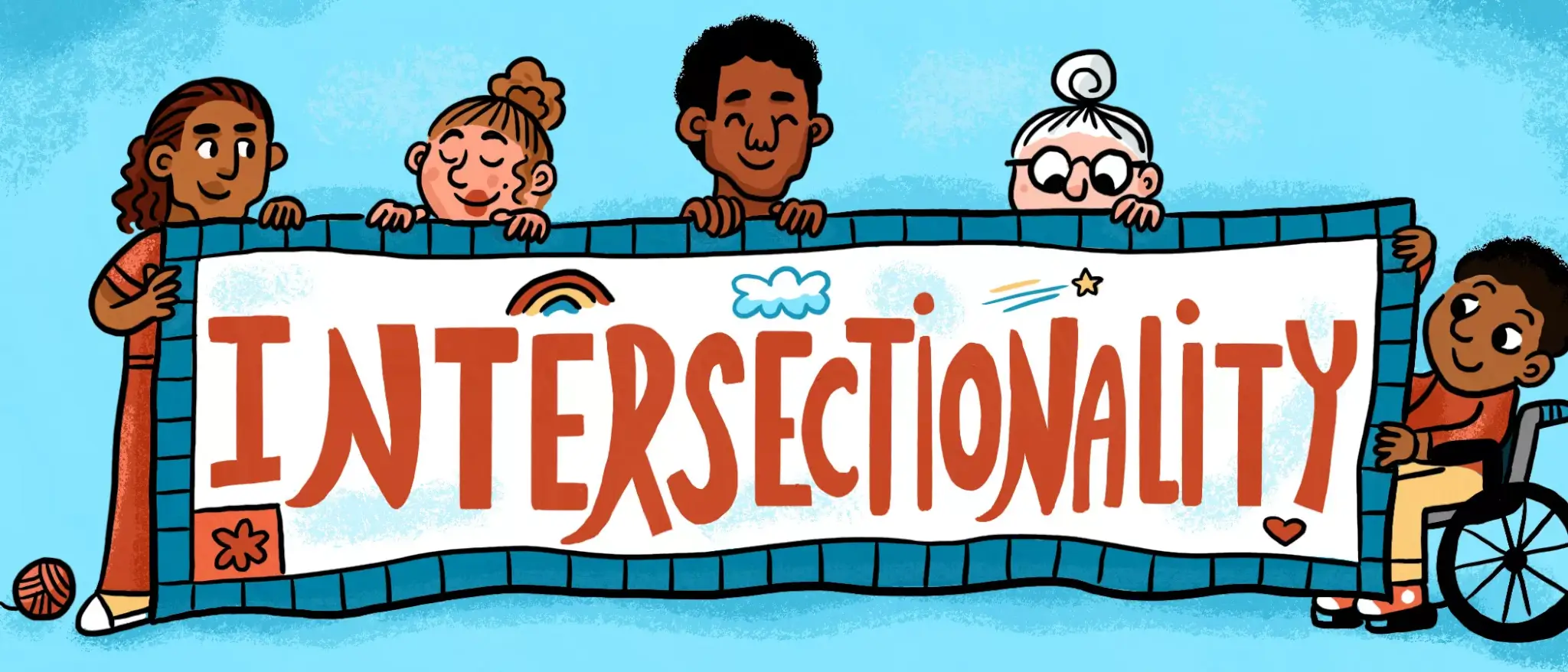Intersectionality is a term used to describe what it sounds like: intersections.
But instead of a series of roads, streets, and avenues intersecting, it refers to identities, formed in part by sets of life circumstances. Intersectionality is not so much a theory as it is a framework to acknowledge the idea that no one has a singular identity; rather, we're all complex individuals with multiple identities.
Defining intersectionality
Intersectionality refers to the various ways an individual’s many identities and experiences shape who they are and how they move through the world.
While race or gender identity may be the attributes that often get the most attention, there are many more layers to consider. Other factors like your hometown, your education, if you had cable television (and if you were allowed to watch it) all contribute to who you are. We mention this because it’s important to realize that everyone’s identity is intersectional.
This brings us to the next aspect of intersectionality: the relationship between an individual and society. Intersectionality is also a framework for thinking about how the various pieces of your identity create the potential for favorable or unfavorable treatment in society by both individuals and systems. It addresses not only the question of “Who am I?” but also “How am I treated by the world?”
In nearly any society, some social identities are privileged over others (and are therefore assigned more power). People with identities that are socially disadvantaged can experience more discrimination on the basis of those identities. This informs their expectations for how they might be treated; women may expect to experience gender discrimination, Black people may expect to experience racial discrimination, and so on. Intersectionality explores how these factors combine to create a unique potential for bias and discrimination, especially if two or more social identities are stigmatized.
The history of intersectionality
In 1989, UCLA and Columbia University law professor Kimberlé Crenshaw, a renowned civil rights scholar and advocate, coined the term “intersectionality” in her paper “Demarginalizing the Intersection of Race and Sex: A Black Feminist Critique of Antidiscrimination Doctrine, Feminist Theory and Antiracist Politics,” for the University of Chicago Legal Forum. Crenshaw is also considered the architect of Critical Race Theory, a concept that teaches aspects of US history in the context of slavery and ongoing racist patterns.
Crenshaw formulated the intersectionality framework to address the experiences of Black women — who were largely left out of early feminist discourse — and the importance of anti-racist and feminist work. In the decades since, the theory has evolved and expanded in scope to include all identities, especially those facing discrimination and inequality like members of the LGBTQ+ community, immigrants, disabled people, and others.
Intersectionality in the workplace
Okay, so we know that privileges and identities contribute to how we move through the world — and that includes our workplaces, right? An inclusive workplace built on the foundation of intersectionality is one where we can embrace all parts of our identities at work and how we can create an environment where our colleagues can do the same.
Why is intersectionality important?
Research shows us that those who are often marginalized by society experience worse treatment than those in socially privileged categories. Women are more likely to be recipients of sexual harassment than men. People of color are more likely to be recipients of race-based discrimination than white people. So when someone’s intersection is a combination of multiple marginalized identities, they have to manage the potential for more (and more specific) discrimination.
And it’s not just about discrimination — those who are often marginalized also lack equitable opportunities for advancement. An article published by Harvard Business Review reported that women of color are more likely than white women to feel they must compromise their authenticity if they want to be leaders. Of those surveyed, 72% of Black women, 53% of Latinas, and 52% of Asian women say “executive presence” at their company is defined as conforming to traditionally white, male standards, whereas only 44% of white women felt that way.
A workplace that understands and practices intersectionality can help address these systemic problems and can act as a role model for equitable treatment for society at large.
3 tips for a more inclusive and welcoming workplace
Understanding that we all have identities that influence our lived experience is essential because it helps us grasp the ways in which parts of our identities may generally be privileged by society over others’. With this recognition, we can work to make our workplaces more inclusive of all identities.
How, you ask? Here are three tips we offer in our Diversity, Equity, Inclusion and Belonging (DEIB) training:
1. Ask the right questions
Start by asking yourself, “What is the experience of being a woman in the workplace?” Or, “What is the experience of being a Black person in the workplace?” Or, “What is the experience of being an Asian American person in the workplace?” Think about the many facets that make up a person’s identity and ask yourself how each of them might impact a person’s experience at work. Even being unable to imagine this can be a useful learning experience given that it means you may need to research or actively listen to your colleagues with those identities more.
Then, start to combine your questions. “What is the experience of being a Black woman in the workplace?” “What is the experience of being an Asian American woman who is neurodivergent and a parent?” Note how the overlap begins to change the answers. What you’re discovering are the places where systemic biases, inequities, and privilege overlap. None of these parts are “bad,” they simply are and it’s essential to recognize them.
The next step is asking yourself, “Are any parts of my identity privileged over others? How have they helped me get to where I am today? How can I use those privileges to create meaningful change?”
2. Listen
We're not after diversity for diversity’s sake. So, if you already have a diverse team — first, great job! — and second, your workplace can now work toward being more inclusive, and ensuring everyone feels a sense of belonging.
Maybe you've noticed that turnover is high among employees of color, LGBTQIA+ employees, employees with disabilities, and women. Ask yourself: does your company have the structures required for fostering a safe and inclusive environment in place? That includes avenues for people to take if they want to voice concerns. And if someone does present you with an incident or a bias — listen.
3. Acknowledge vulnerability
In the words of Brené Brown, “Vulnerability is not about winning. It’s not about losing. It’s having the courage to show up when you can’t control the outcome.”
Identity work is vulnerable; it can make us feel exposed, othered, and uncertain. But, it can also be empowering, affirming, and has the power to connect us deeply. This work is not for the faint of heart, so be patient with yourself and others. If you make a mistake, apologize and do better next time. We’re continuing to learn with and from one another, even when we cannot always control how we’re seen or treated; and by doing so, we’re taking the necessary steps toward a better workplace.
The final word
The term “intersectionality” is a way to highlight multiple identities — from race, age, gender, class, sexual orientation, and religion, to lived experiences like growing up in a poor or rich neighborhood.
Intersectionality is also a framework for recognizing how our social identities converge to create specific modes of disadvantage and discrimination. Understanding and engaging with this framework can help us all better connect with one another in the hopes of creating a more inclusive workplace.










